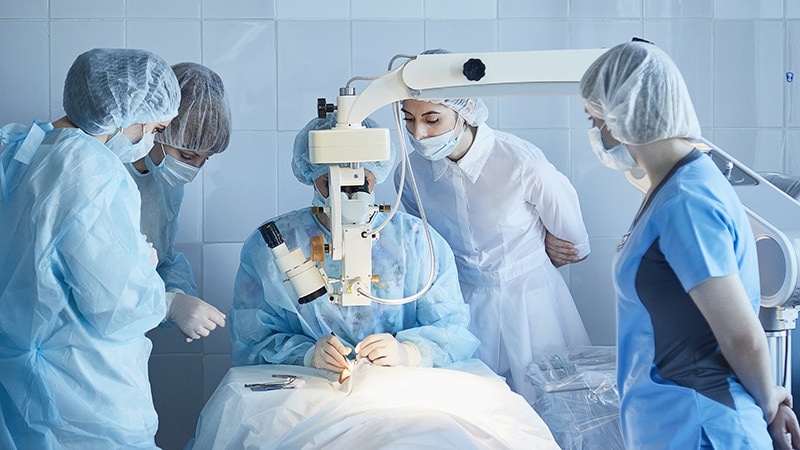Ophthalmologists can safely perform interventions like cataract surgery without worrying that their patients will face an increased risk of acute myocardial infarction (AMI) following the procedure, according to a case-crossover study published in the Annals of Internal Medicine.
Abhijit Sen, PhD, senior researcher in epidemiology at the Norwegian University of Science and Technology and Center of Oral Health Services and Research in Trondheim, Norway, explained that many tests and evaluations often precede ophthalmological procedures because of fears about complications that may follow the procedures.
“Very little is known whether these procedures actually raise an individual’s short-term risk [of having an AMI],” said Sen. “We as researchers are mainly interested in [looking at] heart attack, because heart attack is the leading cause of death for men and women.”
The study involved 353,031 patients in Norway and Sweden, identified through patient registries, with first-time heart attacks who were aged 40 and older. The analysis included 806 patients with AMIs.
Sen and his co-investigators designed the study so that patients would serve as their own controls. They compared exposure to ophthalmologic procedures in the 0-to-7 days before AMI diagnosis (the hazard period) to a 7-day span 30 days earlier (the control period 29 to 36 days before AMI). The researchers estimated the relative risk of having an AMI the week after an ophthalmologic procedure by comparing the two time periods.
Sen and his team also stratified the data using several variables including age (younger than 65 years vs 65 years and older), duration of procedure (less than 20 minutes vs 20 minutes and longer), anesthesia (local or general), presence of comorbidities (with no comorbidities denoting a low-risk patient and at least one comorbidity denoting a high-risk patient), and surgery subtype. They found none of these variables influenced risk of an AMI.
Surgeries were categorized into three subtypes: (1) surgical procedures on eyelids and extraocular muscles, generally done by oculoplastic surgeons; (2) surgical procedures done on the eye’s anterior segment, including cornea, lens, and anterior chamber angle, generally done by anterior segment surgeons, cataract surgeons, or glaucoma surgeons; and (3) procedures on the vitreous body and retina, generally performed by vitreoretinal surgeons.
Procedures were categorized as low, intermediate, or high invasiveness if they required general anesthesia or involved penetration of the eye. Procedures meeting both criteria, such as retinal detachment, were labeled high, while those meeting one criterion, such as cataract surgery, were classified as intermediate. A procedure such as injection into the eyelid for blepharospasm was considered low invasiveness.
Sen and his co-investigators found a decreased possibility of AMI in the week after an ophthalmologic procedure, compared with during the control week (odds ratio, 0.83; 95% CI, 0.75 to 0.91).
“Ophthalmologists may have postponed or canceled surgeries to reduce the risk of complications,” said Sen, noting that deferring ophthalmologic procedures as a matter of course to prevent AMIs is not needed.
Phil Hooper, MD, FRCSC, a vitreoretinal surgeon and president-elect of the Canadian Ophthalmological Society, told Medscape that the study data will support decisions to proceed with eye procedures in patients who do not have optimal blood pressure.
“You occasionally will run into a patient that doesn’t have very well-controlled blood pressure,” said Hooper, who is also an associate professor at Western University in London, Ontario. “And the data would suggest that given that there were a number of patients in the study that had hypertension, that were not well controlled, that you can go ahead with the surgery.”
Hooper agreed with the viewpoint in the study’s accompanying editorial, which cited data that patients of high-testing physicians wait longer for cataract surgery and are at increased risk for events like falls compared with patients of physicians who order fewer tests.
“Delaying the patient to control their blood pressure can lead to an excess risk for other adverse outcomes during that waiting period,” he said.
Hooper added that the case-crossover design was noteworthy, for it managed to eliminate the influence of other variables on the results.
“The design is interesting because it did allow them to get rid of the confounders of patient health that otherwise would be seen in a case-control study, because the patients were their own controls,” said Hooper.
The study was supported by the Central Norway Regional Health Authority and the Swedish Research Council. Sen and Hooper have disclosed no relevant financial relationships.
Ann Intern Med. Published online March 22, 2022. Abstract, Editorial
For more news, follow Medscape on Facebook, Twitter, Instagram, and YouTube.

